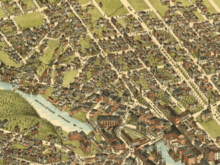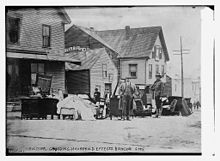


The Great Fire of 1911 took place in Bangor, Maine, United States, on April 30 and May 1, 1911. A small fire that started in a downtown shed went out of control and destroyed hundreds of commercial and residential buildings.
History
It started in the afternoon of April 30, 1911, on Broad Street. High winds had spread it to a shed on Exchange Street and the Universalist Church on Center Street by 4:10 PM, from where it spread into the residential neighborhood on Center Street Hill. In 1907, the National Board of Fire Underwriters had mapped the fire geography of Bangor, and predicted that a large fire could have spread from that area.
The fire eventually became so large that the glow in the sky could be seen in Belfast. It was brought under control on Monday morning, May 1, 1911, but before it was out, it destroyed much of Downtown Bangor. The Post Office, the Custom House, and Norumbega Hall were lost, along with the three buildings of Bangor High School and the Bangor Public Library. Somehow, City Hall survived, despite being in the direct path of the fire. The library's collection of 70,000 volumes was destroyed, along with much of the Bangor Historical Society's collection. An attempt to slow the fire by dynamiting buildings in its path failed. A light rain that began overnight did much to bring the fire under control. In total, 285 residences, 100 businesses, and 6 churches were destroyed, doing $3.2 million damage and leaving hundreds homeless. Before the fire, insurance companies had considered Bangor a good risk.
Remarkably, only two people died: one Brewer man who was caught in electrical wiring while crossing a bridge, and one firefighter.
Fire crews were called from as far away as Lewiston and Portland. After the telephone company caught fire, the wire chief climbed a pole and cut in on a trunk line to make aid calls. One team that was sent up from Boston, Massachusetts, ended up fighting a fire in Portland when their train stopped there.
The area destroyed by the fire was quickly rebuilt, with many architectural commissions going to New York and Boston firms (such as Carrere and Hastings and Peabody and Stearns), as well as local designers Wilfred E. Mansur, C. Parker Crowell, and Victor Hodgins. A large portion of the rebuilt area (43 buildings) was listed on the National Register of Historic Places in 1984 as the Great Fire of 1911 Historic District.
References
- "Is New York City In Danger of Being Fire Swept?". New York Times. January 14, 1912. Retrieved 2011-06-07.
- "Little Bangor's Big Fire". Editorial. New York Times. May 2, 1911. Retrieved 2011-06-07.
- "Already Planning to Rebuild Bangor". New York Times. May 2, 1911. Retrieved 2011-06-07.
- "Bangor Fire Loss Set At $3,280,482". Christian Science Monitor. July 29, 1911. Archived from the original on May 24, 2011. Retrieved 2011-06-07.
- Russell, Eric (April 29, 2011). "A city rebuilt from ashes: Bangor's Great Fire of 1911 remembered". Bangor Daily News. Retrieved 2015-01-28.
- "$6,000,000 Fire Sweeps Bangor". New York Times. May 1, 1911. Retrieved 2011-06-07.
- "Bangor In Focus: The Great Fire of 1911". Retrieved 2015-01-28.
Further reading
- Marc Berlin; Ardeana Hamlin; Richard Shaw; Gig Weeks (1999). The Story of Bangor: A Brief History of Maine's Queen City. Bangor, ME: BookMarc's Publishing.
External links
- Flickr: The Library of Congress' photostream / greatfireof1911
- "Web Extras: Bangor Lumbering & The Fire of 1911". Maine Experience. Maine Public Broadcasting Network. Archived from the original (ASX) on 2008-08-14. Retrieved 2008-06-19.
- "Bangor Fire Department of 1911". Bangor Public Library. Archived from the original on 2015-01-11. Retrieved 2015-01-28.
44°48′11″N 68°46′12″W / 44.80306°N 68.77000°W / 44.80306; -68.77000
Categories: